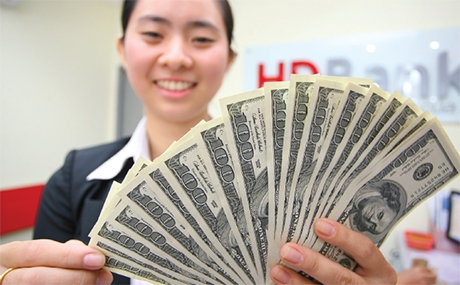Stable forex market tipped

The factors include improved trade-generated forex reserves, a trade surplus, high remittances and the State Bank of Vietnam’s (SBV) anti-dollarisation programme.
The interbank exchange rate on the first days of 2013 was VND20,828 per dollar, which was kept the same since December 24, 2011. The USD buying and selling price listed at commercial banks for most of 2012 fluctuated within +/- 1 per cent as committed by the SBV at the beginning of the same year.
Banking expert Can Van Luc said the demand for foreign currency was low, while the foreign currency supply was still good, creating conditions for the SBV to buy back foreign currency.
Luc explained that this supply included remittances expected to reach $10-11 billion in 2012 and a $3.9 billion disbursed official development assistance (ODA), which was higher than $3.65 billion of 2011. Moreover, the low demand for foreign currency was a result of the anti-dollarisation programme.
“In 2013, the SBV should be careful in announcing whether to continue maintaining the variation of the exchange rate within 2-3 per cent like 2012 or not, as those supporting factors can change negatively. However, one advantage for the SBV to control forex market is the anti-dollarisation programme which limits foreign currency lending and borrowing demand,” said Luc.
Tong Minh Tuan, head of research at BIDV Securities Company, expected the forex market would remain stable in 2013.
“If there is any adjustment, it will happen in the last six months of 2013 due to a government economic stimulus to support growth,” said Tuan.
General Statistics Office data showed that in 2012 Vietnam achieved a trade surplus of $284 million, after 20 years of running a deficit, creating a sound base for the SBV to replenish the forex reserve.
At a year-end meeting with representatives of international financial and foreign credit institutions in Hanoi, SBV Deputy Governor Le Minh Hung said the surplus of overall balance of payment in 2012 was about $10 billion, much higher than any previous projection.
“As a result, the international reserves have more than doubled compared to the beginning of 2012, providing ample liquidity for the market without causing any inflation pressures, while maintaining a very stable foreign exchange market and exchange rate during the whole course of 2012,” he said.
According to the Ministry of Planning and Investment’s report on 2013 socio-economic development issued on January 3, 2013, Vietnam’s forex reserve in 2012 reached 12 weeks of imports.
In late December 2012, the World Bank stated that the country might have international reserves for 2.3 months of imports in 2012. However, this level is still low compared to other countries in the region.
Meanwhile, Standard Chartered Bank in a report named “Vietnam-steadying the ship” released early last December stated that it expected USD/VND to remain stable in 2013 at around VND21,000. According to this bank, the stabilisation in the trade balance and lower consumer price index (CPI) were positive for the local currency.
HSBC in its latest report named “Vietnam at a glance” released on January 3, 2013 also forecast the VND/USD exchange rate in 2013 at VND21,500 per dollar.
What the stars mean:
★ Poor ★ ★ Promising ★★★ Good ★★★★ Very good ★★★★★ Exceptional
Related Contents
Latest News
More News
- Tax sector wraps up 2025 and sets priorities for next year (December 25, 2025 | 14:00)
- A tipping point for digital and hybrid wealth management in Vietnam (December 23, 2025 | 13:33)
- $250 million deal targets women-owned SMEs, sustainable agriculture (December 22, 2025 | 17:40)
- Stock market posts resilient 2025 performance (December 19, 2025 | 18:17)
- Citi Vietnam receives 2025 AmCham CSR recognition (December 19, 2025 | 16:35)
- As global green supply chain reshapes, will Vietnam be left behind? (December 19, 2025 | 08:00)
- Banks gear up for massive capital increases (December 18, 2025 | 17:04)
- Securing capital and efficiency for Vietnam’s 2026-2030 growth ambitions (December 17, 2025 | 10:00)
- Energy sector in need of blended finance mechanisms (December 17, 2025 | 09:00)
- Vietnam still has room to mobilise capital for sustainable growth (December 17, 2025 | 08:57)

 Tag:
Tag:





















 Mobile Version
Mobile Version